Carefully considered and balanced realistically, these components create a steady base from which to reach that pot of gold. But is it really possible to unlock the profitable opportunities that hide behind the dramas of day to day business leadership?
How do you set your goals and how do you measure your achievements?
If we sit around the table at an intime PROFIT Business Builder Boardroom Event to discuss goals, we would probably find that our personal objectives are similar - to build a sustainable wealth that will take us into a comfortable, healthy and enjoyable retirement. But if we compare corporate goals or at least the plans needed to achieve them, they may well be very different.
Here are some thoughts:
Start with pragmatic goals and make them SMART:
Specific – It is likely that, to some degree, your business goals will reflect your personal goals and vice versa. The statement of intention should include specifics such as what, why, who, where and when. If the goals are vague they’ll be difficult to achieve by virtue of definition.
 Measurable – you must be able to track progress and measure effectiveness, which follows on from specifics. Include values in your goals such as quantities, values and deadlines.
Measurable – you must be able to track progress and measure effectiveness, which follows on from specifics. Include values in your goals such as quantities, values and deadlines.Agreed – whether or not you are the sole decision maker in the business, your decisions affect others either in the organisation or at home. Consider and include others for agreement in and of the planning process.
Realistic – goals should stretch current and past expectations. Such goal statements are broader than budgets and perhaps more strategic than targets. Is the goal achievable within the constraints of assets and skills within your control?
Time-bound – your goal(s) should have deadlines … by when will the goal be achieved? As well as the core deadline, key points should be included to help evaluate progress along the journey to success.
Well-considered goals deserve an equally well-considered Plan detailing the marketing, sales and operational processes needed to achieve success.
Business growth planning takes on many forms. The simpler, more specifically you detail your Plan, the more likely you’ll be to stick to it. Keep your planning relevant to the now. Rather than a strategic overview with SWOT appraisals of market positioning (we assume you already know pretty much where you are in competitive terms and your product, price, brand, customer balance have already been considered), this is a tactical Plan.
Your Plan should budget and schedule the additional sales and marketing activity needed to lift your product / service exposure to your core or fresh prospect base, sufficiently to achieve your Goal.
Very simply and generically – what might you consider?
 Who / where / what is your market. Do you know your audience and how to reach them? Take a look at your sales in the light of the 80:20 rule and loosely model the 20% of your clients who deliver that 80% of your sales - you want more of them.
Who / where / what is your market. Do you know your audience and how to reach them? Take a look at your sales in the light of the 80:20 rule and loosely model the 20% of your clients who deliver that 80% of your sales - you want more of them.Image / message / presentation. Review your USPs and tighten the corporate proposition in a language your audience (that 20% model above) understands. Then think about its visual and physical presentation in a letter; on an e-mail; a postcard; banner advertisement; Google Ad lineage etc.
Consider the media opportunities to put your revitalised message on your audience’s desks, laps, screens, breakfast tables. Price the options and prioritise the activity. Then tweak the message to suit the platform / reader environment – one size does not fit all.
With audience, message and media sorted, schedule the invigorated activity ensuring that you have operational procedures in place to track the response and measure the effects. Employ Google ads with tracking through AdWords. Drive a Squeeze Page to build your database and ‘follow’ web visitors with a highly targeted Re-Marketing campaign.
ANYONE can employ such techniques. This is not highbrow jargon-driven marketing for the Big Boys (and Girls). It’s real, it’s sensitive … and it works.
Activity / activity / activity. The bad news - it doesn’t do it by itself. More sleepless nights? The Goal, The Plan, The Resources. Two out of three does not really work and without the Resources to effectively action The Plan…
Effective Planning is just one of the essential business development tools covered as part of the 7 Step Business Builder programme from intime PROFIT.
Through a series of Boardroom Events and One-to-One meetings over a period of 90 days, Business Builder members learn and apply valuable techniques designed to help them grow the businesses they own and manage.
The One-to-One meetings tailor the techniques covered in group sessions in the Boardroom, to your own business, its status, market, resources and goals using intime PROFIT's proven Three Step Process ... to Review, Plan and Action:
Review - We look at the current picture and agree on your aims and objectives.
Plan - Then we identify the specific activities needed to move you closer to those objectives.
Action - And we help you to make the commitment, action the key elements of the plan, tracking results for further review.
Call, mail, view and start making a difference today:
Call intime PROFIT on 08456 437 497 or e-mail intime@intimeprofit.com





No comments:
Post a Comment